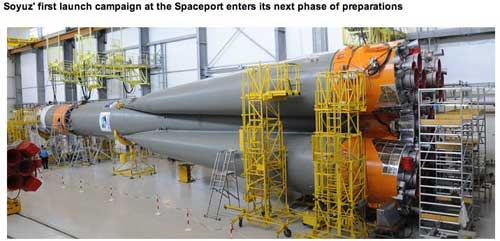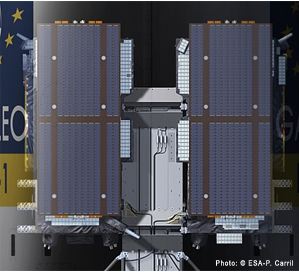
Space launch history is being made at a dual pace in French Guiana as the first two Soyuz missions are readied for Arianespace’s introduction of this medium-lift workhorse vehicle from its new operations base at the Spaceport.
as the first two Soyuz missions are readied for In parallel to the final preparations for Soyuz’ milestone maiden flight on October 20 with a payload of two Galileo navigation satellites, the second launch campaign has now begun for a December mission with six spacecraft that will perform governmental and civilian Earth observation duties, as well as military electronic intelligence-gathering.
“We’re right on the timeline, and everything is proceeding well from all aspects,” said Jean-Claude Garreau, Arianespace’s Launch Site Operations Manager for the mission.
The no. 1 Soyuz will move to the launch pad on Friday, October 14, where this basic three-stage vehicle is to be fitted with its upper composite consisting of the Fregat upper stage, the two Galileo satellites and their two-piece protective payload fairing.
To prepare for its upcoming rollout from the Spaceport’s MIK launcher integration building, the basic three-stage Soyuz has been installed on a transporter/erector rail car that performs the horizontal transfer to the Spaceport’s purpose-built massive concrete launch pad. Once in place, the rail car’s main support beam will raise Soyuz to the vertical position, allowing the launcher to receive its upper composite during integration operations performed inside a tailor-made 52-meter-tall mobile gantry.
This payload integration procedure is a key difference in the Spaceport's launch processing compared to the long-operating Soyuz facilities at the Baikonur Cosmodrome in Kazakhstan and Plesetsk Cosmodrome in northern Russia. It allows payloads to be installed on Soyuz vehicles in the vertical position – as is traditionally performed with Western launch systems – and is a change from the horizontal integration traditionally performed at the Baikonur and Plesetsk Cosmodromes.

The two Galileo satellites are shown installed side-by-side on their dispenser system, which was developed for Arianespace by RUAG Space Sweden.
The October 20 inaugural Soyuz mission from French Guiana, designated VS01 in Arianespace’s launcher family numbering sequence, is set for liftoff at 7:34 a.m. local time in French Guiana (10h34 UTC). This 3-hr. 49-min. flight will deploy the two Galileo satellites into a circular medium-Earth orbit at an altitude of 23,222 km., inclined 54.7 degrees.
A payload dispenser developed for Arianespace carries the two Galileo satellites in a side-by-side arrangement for the VS01 flight, and will use a pyrotechnic separation system to release them in opposite directions.
These satellites are the first of four In-Orbit Validation (IOV) spacecraft to form the operational nucleus of the full 30-satellite Galileo navigation constellation. Developed in a collaboration of the European Space Agency and European Union, Galileo is Europe’s program for a global navigation satellite system that provides highly accurate, guaranteed global positioning services. It will be interoperable with the U.S. Global Positioning System and Russia’s Glonass network.
Both IOV platforms to be launched on October 20 were produced by EADS Astrium, and have a launch mass of approximately 700 kg. each. The second pair of Galileo IOV spacecraft is to be orbited by Soyuz in 2012.
With preparations for the VS01 flight reaching their peak, activity for the VS02 launch has begun with initial checkout of this mission’s Fregat upper stage in the Spaceport’s MIK launcher integration building. For its mid-December liftoff, the VS02 Soyuz will carry the French CNES space agency’s Pleiades optical Earth observation satellite, accompanied by five supplemental payloads: four French Elisa micro-satellites for a demonstration of defense-related electronic intelligence gathering (ELINT) from orbit; and the Chilean SSOT (Sistema satelital de Observación de la Tierra) optical satellite for civilian and defense Earth observation.

